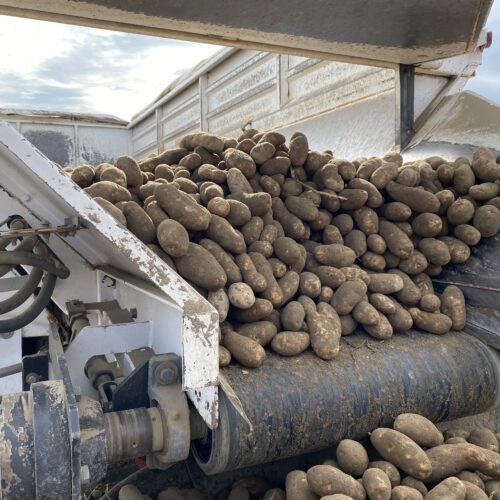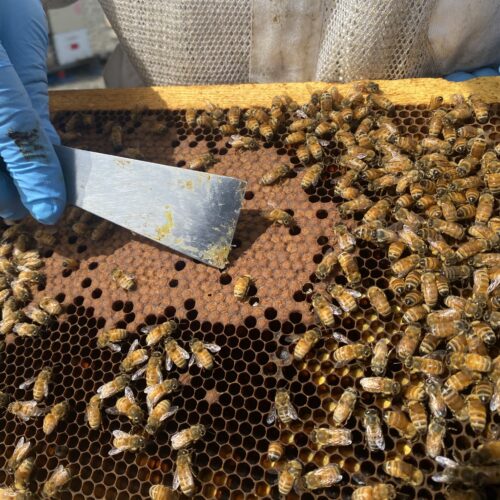Chris Sybrandy, a dairy farmer in Skagit County in northern Washington, says he recently helped haul more than 40 dead animals out of barns for his friends nearby.
“I made a decision that I needed to help them take their cows out, so they didn’t have to take their own animals out,” Sybrandy says. “Having raised these cows from babies, I didn’t want them to have to take them out themselves.”
The worst of last week’s flood waters are slowly starting to recede in northern Washington, after about 100-thousand cattle were jeopardized, most of them by flood-related disruptions to the feed supply.
The animals had been surviving on an island of dirt Sybrandy calls a “critter pad,” but despite the moat that surrounded them, the creatures of habit tried to get to the milking barn when it was time.
“Their udders were under tremendous pressure,” Sybrandy says.
The animals struggled and panicked in the deep water in the middle of the night. The farm family was submerged up to their necks in the frigid water as they tried to save them for several hours. Most cattle were able to be herded, swimming back to the island above water, but more than 40 perished.
Sybrandy helped remove all the dead animals from across the farm with large tractors.
“You try to shut off your emotions, it’s a job,” Sybrandy says. “I was concerned for the sake of the owners. I had a job to do, I wanted to treat the cows’ bodies with the most respect I could. I don’t know if I’ve really processed it or not.”
Even for the ones that survived, floodwaters are a stressful situation for cows, which usually spend half the day lying down. Experts say they can get sick, even after they’re dry.
“They were just standing and they couldn’t get to stalls and lay down,” says Fred Likkel, who heads up the advocacy group Whatcom Family Farmers. “They perhaps couldn’t get to being milked.”
If not milked daily, cows start to dry up. If they can’t lay down, cattle get stressed and sick.
Fodder fight
In a wider crisis across Western Washington, dairy owners are now running out of feed. A large feed plant — called EPL Feed — in Sumas, in Whatcom County, has also been badly flooded. The mill’s electronics are fried, parts have been flooded under three feet of water for days and the electricity is messed up. EPL feeds about 60 percent of the dairy cattle in Western Washington — clear south to Chehalis.
A freshly-calved milking cow can eat upwards of 120 pounds of feed per day. New bovine mothers need a lot of calories to produce gallons of milk each day — sort of like an elite athlete.
On top of the mill being down, there are massive amounts of stored feed at flooded farms that have gone bad from the fetid water in Skagit and Whatcom County. And while many farms run dangerously low on fodder, it could take days for the mill to fully start up again. That means there’s a shortage of milled food for the cattle. The race is on to grind up and pelletize food for cattle and get it out on highways and country roads headed to farms.
The plant’s been down for about a week. It usually produces about 3,000 tons of food — that’s about 125 semi loads — a week. Most goes to feed dairy cattle and backyard flocks of chickens.
“It’s almost impossible to catch up from that, ” says Jason Hoekstra, the CEO of EPL Feed. “Recovering from this is going to take potentially months.”
A plane and a sports car
Hoekstra knew he needed 10 special electrical control modules to make the plant run — and each day the plant didn’t run, the trouble for farmers deepened.
He did a nationwide search. His usual parts dealer didn’t have them. He found some in southern California, near San Diego. He told them ‘spare no expense’ getting the 10 units to Washington. They were put on a plane, and driven by a private courier in a sports car from Seattle north to the plant. The parts arrived at 10 p.m. Friday night. The electricians have been working feverishly since then to install the modules and get parts of the plant back up. Monday afternoon they were able to flip on a portion of the plant. But there’s still so much work to be done, Hoekstra says.
“So the longer this goes on the further behind we get,” he says. “And to catch back up, you know our first goal is to just get everyone something. And try to buy some time.”
Disease, rodents and parasites
The state’s interim vet, Amber Itle, lives in Bellingham, Washington, near the flooding. She knows many of the farmers and veterinarians who are dealing with it.
She says as the flood waters recede, she’s just worried about stressed animals falling sick and post-flood influxes of parasites and rodents.
Many animals stood in icy chest-high water without food, clean water or a place to lie down for as long as three days. She says that does several things: The animals might have become hypothermic, stressed or had their udders in the filthy water, which could cause mastitis in the days and weeks later. Their hooves can also become softened by the constant exposure to water and can form sores. Feed changes can make this worse in hooved animals — a condition called laminitis.
“That’s where the hoof wall separates,” Itle says. “It’s a very painful condition for most cloven hoofed animals, so that’s something to watch for if you see a lot of weight shifting.”
Itle says another problem is a possible boom of rats and mice, which often follow flood events. And they can carry diseases on their feet that can make animals and even people sick like E. Coli, salmonella or leptospirosis.
“There is going to be a surge of both parasites and rodents after a flood,” Itle says. “They [mice] carry it around on their feet.”
Total milk production could be affected in Western Washington. Many of these thousands of cows will drop their production after not being milked for several days, Itle says. And they won’t regain their milk-producing capacity until after their next calf is born a year later, she explains. Some farmers might have to cull out some low-producing animals.
“The flood damage and strain on feed supplies will definitely affect production for the dairy farms,” says Dan Wood, executive director of the Washington State Dairy Federation which is coordinating much of the effort to help Whatcom and Skagit county farmers, in an email. “It’s too difficult to speculate on the impact to the consumer prices.”
Back in Skagit county, Sybrandy says he’s worried about the high suicide rate in farming and the terrible trauma his friends have experienced this last week.
“For some they may look at this as a sign to retire,” he says. “Some may find a farm someplace else that won’t flood again. Some others might use this as a learning process and prepare for a flood at another time. I just don’t want it to end people’s dreams. It’s a cliche, but farming isn’t what we do, it’s who we are.”
***
Wood says donations to help farmers can be mailed to the Washington State Dairy Federation, with “emergency fund” on the check, at P.O. Box 1768, Elma, WA 98541 or online here.




















